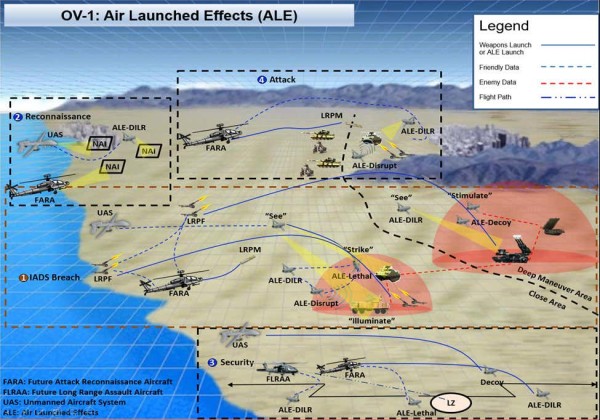

The Army is on the hunt for a swarm of drones that can conduct surveillance and reconnaissance, pose as decoys, wage electronic warfare, and even deliver lethal payloads in an airborne assist to the service’s next-generation helicopters, according to a new request for information.
The Army’s Combat Capabilities Development Center published an RFI last week detailing a need for air-launched unmanned systems it calls “Air Launch Effects” (ALE) to pair with the Future Attack Reconnaissance Aircraft (FARA) that’s part of the ongoing Future Vertical Lift (FVL) program, which is designed to modernize the service’s helicopter fleet ahead of the next big war.
“The future multi-domain operational environment will present a highly lethal and complex set of traditional and non-traditional targets,” the RFI says. “These targets will include networked and mobile air defense systems with extended ranges, and long and mid-range fires systems that will deny freedom of maneuver.”
To defeat those aggressive air defense systems, the Army wants a swarm of networked drones that can conduct active and passive surveillance, pose as decoys, and aggressively disrupt an enemy’s defenses through both lethal and non-lethal functions — a fleet of suicide drones with ISR and electronic warfare capabilities mixed in.

The ALE effort comprises a family of small (less than 60 pounds) and large (between 150 and 250 pounds) drones that will team with other manned and unmanned platforms to “detect, identify, locate, report (DILR) and deliver lethal and non-lethal effects against threats across multiple scenarios and domains in a constantly changing Operational Environment (OE),” according to the RFI.
The ALEs primary functions of are: passive DILR, or detection and reconnaissance across the electro-optical, infrared, and radio frequency spectrums; active DILR, for more aggressive reconnaissance against hardened targets; decoy, or confusing adversary integrated air defense systems through electronic warfare or other cyber effects; and disrupt, or “reducing threat engagement ranges or preventing the acquire/track/guidance of munitions” against Army assets..
The “synergistic effect” of teaming these various ALE functions with manned vehicles like the FARA should, according to CCDC, “[enable] the penetration, dis-integration, and exploitation of an adversary’s Anti-Access Area Denial (A2AD) comprised of an Integrated Air Defense System (IADS) and Integrated Fires Complex (IFC), as well as surveillance and targeting systems, command, control and communications (C3) capabilities, and essential logistical infrastructure.”
The ALE effort comes amid the U.S. military’s gradual reorientation towards traditional adversaries like Russia and China in the era of “great power” competition, a shift that has left the Army in desperate need of aircraft “capable of operating in a complex airspace and degraded environments against peer and near-peer adversaries with an advanced integrated air defense system,” according to the service.
Indeed, the CCDC RFI’s operational concept envisions how a fleet of unmanned ALE systems might fit in with not just the FARA, but the Future Long Range Assault Aircraft (FLRAA) — also in development under the service’s FVL effort — as the two platforms engage various air defense systems on the ground.
The FARA is intended to replace both the Army’s recently-retired OH-58D Kiowa Warrior scout copters and half of the service’s AH-64 Apache fleet in the coming years, while the FLRAA program will replace the Army’s UH-60 Black Hawk fleet.
The Army in March selected Bell Helicopter’s articulated rotor Invictus and Sikorsky’s compound coaxial rotor Raider X to face off in phase two of the FARA competition, while Sikorsky’s SB-1 Defiant prototype is currently competing against the V-280 Valor developed by Textron and Bell in the FLRAA effort.
While it’s unclear which existing systems might fulfill the Army’s requirements and how they might be integrated across a variety of platforms, The War Zone notes that the ALE RFI comes following air-launching tests of Area-I’s small Air-Launched, Tube-Integrated, Unmanned System 600 drones from the service’s Black Hawk helos and MQ-1C unmanned aircraft over the past year or so.
“With a maximum overall weight of fewer than 30 pounds, the ALTIUS 600 is smaller than what the Army says it is looking for even for the smaller ALE drone, but fits a broad description of the kind of system the service wants,” The War Zone reports.
For more on the technical specifics released by CDCC, check out this excellent War Zone breakdown here.
Related: These new pocket-sized drones may be coming to an Army unit near you
